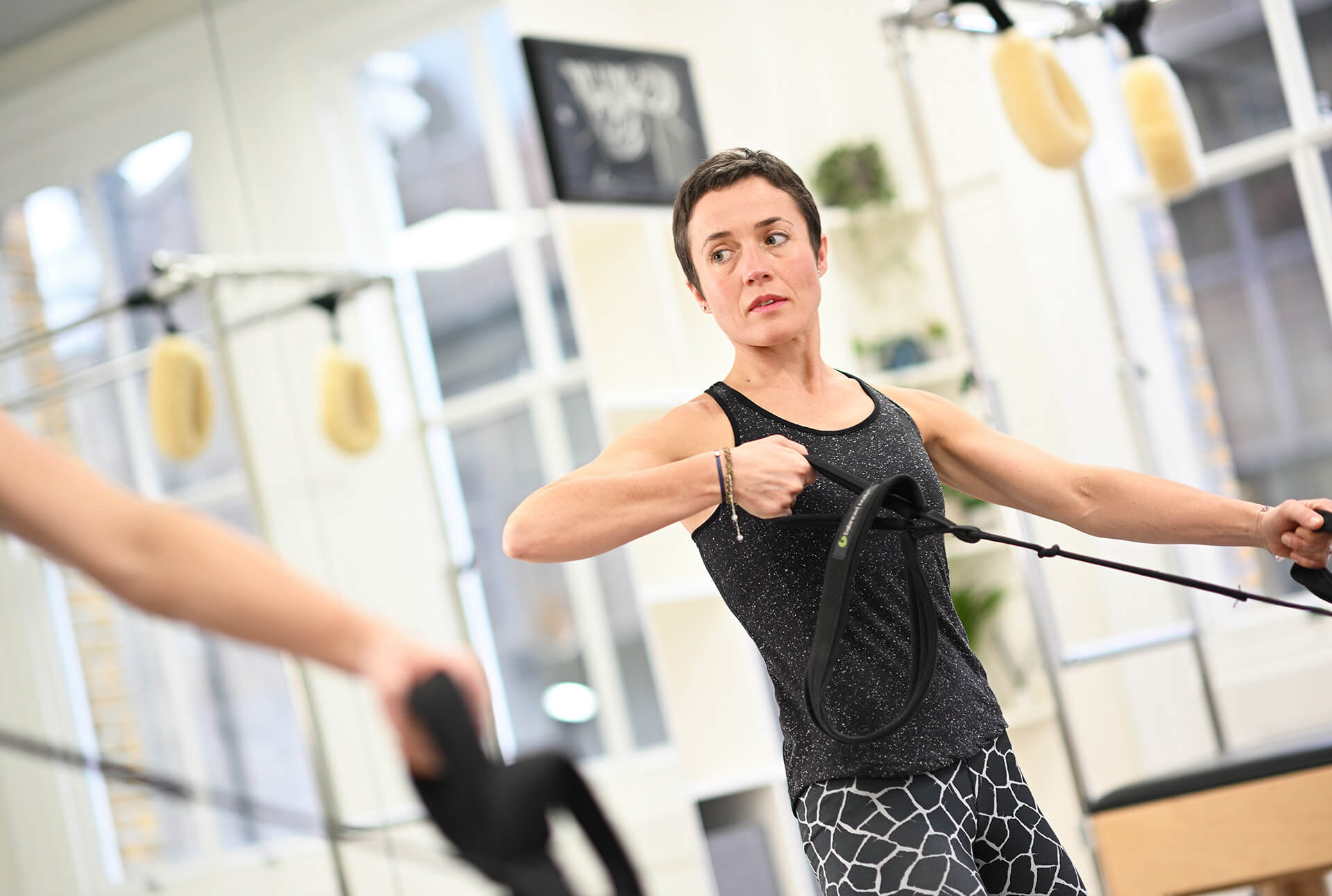The basic Pilates bridge is one of the best Pilates moves out there. It is an exercise we give to almost all of our clients in our Complete Pilates classes.
This is because it is really easy to perform and is safe for pretty much everyone. On top of that, the bridge is a great exercise for rehabbing injuries and building strength. Plus, it targets those parts of the body (bum, hamstring, spine extensors) that bear the brunt of our sedentary modern lifestyles.
The bridge exercise is therefore the perfect addition to a pre-gym activation routine or a circuit-type workout – and for many people it already is an essential part of their fitness routine. However, so often this exercise is executed poorly. If you want to reap the rewards from regular bridging then you need to perform it well.
Sold on the benefits of bridging? Want to learn how to perform it correctly so that you can get a strong bum rather than a bad back from your bridge? Then check out Complete Pilates’s instructions below on how to do the basic Pilates bridge.
How to do The basic Pilates bridge
Equipment:
- A Pilates mat.
- Optional: a block, step or low chair.
Starting position:
- Come to lie on your back with your knees bent and your legs hip-width apart. If you are doing a bridge with elevated feet then place your feet on the block, step or chair now.
- Knees should be bent at about 90 degrees.
- Arms are straight and down by your sides.
- Your pelvis should be in a relatively neutral position. This means that your pelvis and bum is neither tucked under (so that your back is flat) nor is it duck-like and sticking out.

The exercise:
- Take a deep, full inhale and create space in your spine by imagining it lengthening.
- Then start to exhale slowly through an open mouth (rather than pursed lips or out through your nose). Breathing in this way aids the movement of your spine.
- As you do so, press into your feet and start to peel your spine up into the bridge position. Reach long through your thighs and let your knees move away from your head – you should feel the front of your hips opening up as you do so and your glutes start to work.
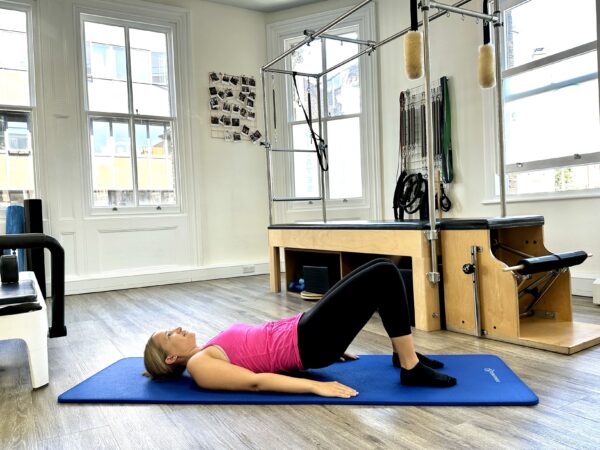
- Make sure those glutes/hamstrings/spine extensors are kicking on by sending your tailbone to the back of your knees and by pulling your heels towards your bum.
- Only bridge up to the point where your shoulder blades are resting on the mat.
- Pause at the top of your bridge and take an inhale here. Or you can stay at the top of your bridge a little longer to build up some strength.
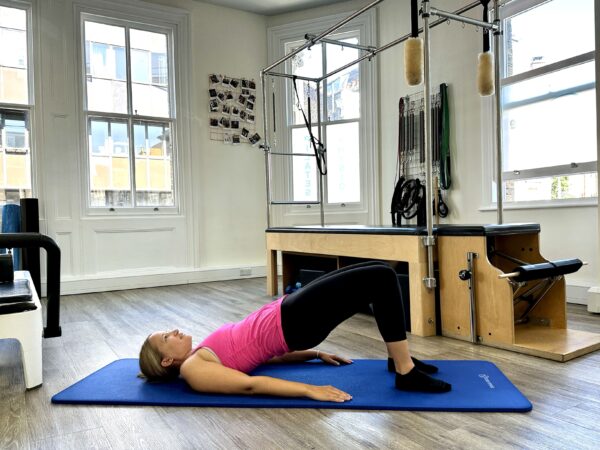
- Exhale and slowly start to bridge back down.
- To initiate this part of the movement, first allow your chest to soften. Then allow the rest of the spine to trickle down segmentally to the mat.
- Keep reaching through your thighs even as you come down. This will create length and space in your body, and therefore helps to decompress your spine.
- Your bridge is complete when your body is back resting on the mat with your pelvis in neutral.
- Repeat 5 – 10 times, or more if you are stronger. Focus on maintaining good form throughout.
Top Tips:
- Back pain whilst bridging? This is a sign you’re not quite doing it right. Make sure you’re not hanging in your lower back while in your bridge and instead really focus on sending your tailbone to the back of your knees.
- Don’t come up too high onto your neck. Remember to keep your chest area soft and your collarbone wide even when your hips are lifted.
- Press into both feet evenly as you move through your bridging so that both legs are equally engaged.
Should be avoided/modified by:
- People with neck pain or neck problems – reduce your range of movement and don’t bridge up so high.
- People with hamstring weakness – keep the number of repetitions low to begin with and slowly build up as you gain more strength.
- People with knee pain – take feet further away from your bottom so that they are no longer bent at 90 degrees.
Variations:
- Keep your spine on a mat but use a block to elevate your feet. This can be used to make the exercise more challenging. At the same time, bridging with your feet flat on the floor can feel subtle and this might make it difficult for you to find the segmental spinal movement we are after. A more exaggerated movement through a bigger range can therefore be a bit easier as you start to build better body awareness.
- If your legs naturally want to drop out to either side as you bridge, pop a soft ball between your knees.
- Legs dropping inwards? A band or Pilates ring around the outside of your thighs for you to press outwards against can be helpful.
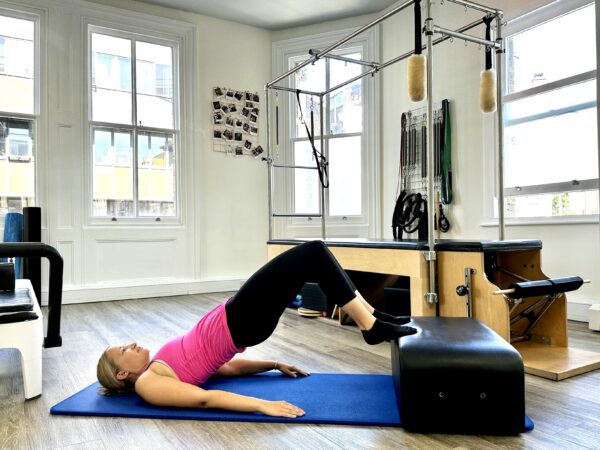
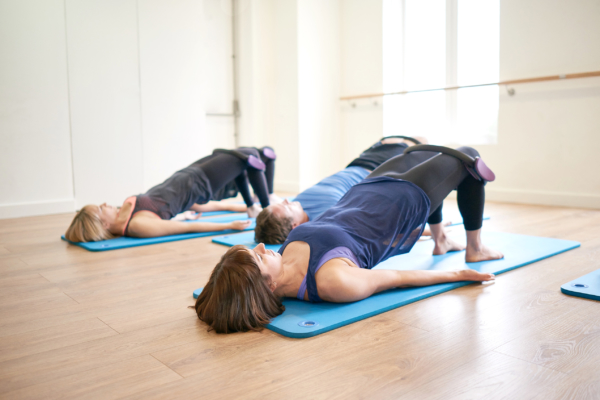
Modify your bridge with a band around your thighs
Benefits:
The basic bridge is great because it strengthens, stabilises and mobilises the body all at the same time!
Bridging strengthens the posterior chain of the body, which means the glutes, hamstrings and spine erectors all get a good work out during a bridge. It also increases hip flexor length and improves hip extension. These are often inhibited/shortened thanks to the hunched-over-the-computer posture we are in most of the time. This means that bridging is a great exercise for people who want better posture. It is especially beneficial for desk-bound office workers.
On top of all that, the bridge exercise helps with the activations of local stabiliser muscles, better body awareness and aids relaxation.
Regular bridging also improves spine mobility, including in the often-stiff area of the mid-spine (see our post to understand why we need a mobile mid-spine).
The latter benefit might not be very well-known, but bridging is really effective when it comes to developing a stable and flexible spine. This is important because having a strong and mobile spine reduces your risk of sustaining back injuries. Creating more movement throughout the spine can also help rehab existing spinal problems.
Gripping and over-tensing muscles can be a big problem for people suffering with injuries. Bridging can help with this by decreasing muscle guarding. This is another benefit not many people are aware of. And is yet another reason why bridging should be practised by pretty much everyone!
Education is key:
These blogs are designed to give information to everyone, however, it is important to remember that everyone is different! If you have not seen one of our therapists and have any questions about injuries, what you have read or whether this may be useful to you, please just ask. We are more than happy to help anyone and point you in the right direction. Our biggest belief is that education is key. The more you understand about your injury, illness and movement, the more you are likely to improve.




